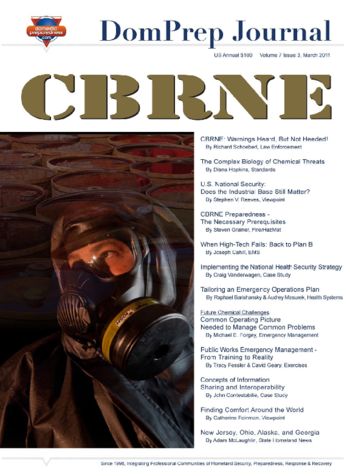

CBRNE Preparedness – The Necessary Prerequisites
Stephen Grainer
March 30, 2011
It is taking longer than originally anticipated, but U.S. policies and plans to cope with future CBRNE incidents, accidental or manmade, are not only being published and implemented at the federal level (then revised and updated – if, as, and when needed) but also being replicated, in operational specifics, at the state and local levels of government as well.

National Level Exercise Roundtable
Kay C. Goss
March 29, 2011
In the early 1800s, the New Madrid Seismic Zone, centered in the southeast corner of Missouri, was
the site of the largest earthquake in U.S. history. The question is not if another quake will occur in
that area, but when will it happen. Listen to Kay Goss’s roundtable discussion on National Level
Exercise 2011, which will address this pressing concern and help the nation be better prepared for the
next “big one.”

The Complex Biology of Chemical Threats
Diana Hopkins
March 23, 2011
Chemicals are chemicals and biologicals are biologicals, but there are some substances – particularly useful in terrorist attacks – that are a little bit of both. Here is a short list of some but by no means all of these potentially lethal substances now receiving greater attention not only from terrorist planners but also from CDC and the U.S. emergency-responder community.

CBRNE: Warnings Heard, But Not Heeded
Richard Schoeberl
March 23, 2011
Question #1: Is the United States prepared to cope with new terrorist attacks in which CBRNE weapons are used to destroy the nation’s critical infrastructure and kill thousands of U.S. citizens at the same time? Answer: Not yet, but policy guidelines have been established and the long-range planning process has started. Question #2: Is there anything else that should be done?

Public Works Emergency Management – From Training to Reality
David Geary and Tracy Fessler
March 23, 2011
For understandable reasons, major disasters – e.g., earthquakes and tsunamis – get most of the headlines and more of the public funds available even in economically difficult times. Local jurisdictions would be well advised, therefore, not only to focus greater attention on emergencies closer to home but also to ask for neighborly assistance if and when needed.

Concepts on Information Sharing and Interoperability
John Contestabile
March 23, 2011
The distinguished former director of Maryland’s DOT Engineering & Emergency Services presents his knowledgeable views on the effective use of design to improve and facilitate not only all-hazards long-range planning but also incident-response capabilities and on-site effectiveness.

Finding Comfort Around the World
Catherine L. Feinman
March 16, 2011
The Navy Hospital Ship USNS Comfort was pushed into the spotlight last year during its 60-day disaster-relief mission in Haiti following the massive 7.0 earthquake that struck that tortured island on 12

Implementing the National Health Security Strategy
W. Craig Vanderwagen
March 16, 2011
Question #1: Is the United States prepared to cope with new terrorist attacks in which CBRNE weapons are used to destroy the nation’s critical infrastructure and kill thousands of U.S. citizens at the same time? Answer: Not yet, but policy guidelines have been established and the long-range planning process has started. Question #2: Is there anything else that should be done?

Future Chemical Challenges: Common Operating Picture Needed to Manage Common Problems
Michael E. Forgey
March 9, 2011
Future chemical challenges facing the United States far into the foreseeable future will be both more frequent and more deadly than those encountered in the halcyon years of the 20th century. Which is why the time is NOW to prepare to meet those challenges head-on and, if prevention does not work, to be much better equipped to deal with the lethal aftermath.

U.S. National Security: Does the Industrial Base Still Matter
Stephen Reeves
March 9, 2011
Well, there is really only one buyer – the U.S. government. And the executive and legislative
branches of that government are under extreme pressure to “cut the budget” as much and as quickly as
possible. The only problem is that this year’s easy choices may never be available again. But that
problem, of course, can be left to the next generation. If there is one.

